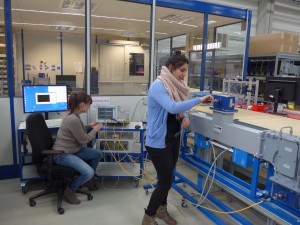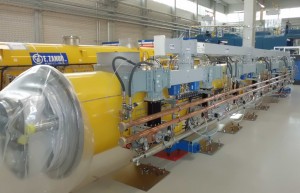For the operation of the European XFEL, 800 cavities will be installed in 100 accelerator modules. The cavity production has already been outlined in the two previous stories published in LC NewsLine (and first published in DESY inForm). For their assembly, there is a weekly transport of cavities to France. From there, they return to DESY as operational modules where they are tested and provided with a custom-made “energy supply” before they are transferred into the tunnel.
The assembly of the modules takes place at the research centre CEA (Commissariat à l‘énergie atomique) in Saclay near Paris. Lorries transport the cavities directly to the gates of the so-called XFEL Village where staff members of the industrial contract partner ALSYOM receive and “check in” the cavities. “We from CEA regard ourselves as the connecting link between research and industry; so it was clear to us to get industry on board with ALSYOM,” explains Olivier Napoly, project leader of the XFEL project in Saclay. “With this, we had a two-tiered learning phase: first, CEA learned from DESY how to assemble XFEL modules; then, we passed on our new knowledge to ALSYOM.”
The whole infrastructure and almost all tools of the XFEL Village are provided by CEA. The main contribution of ALSYOM is the technical staff. In its seven-week production time, each module stays for one week at one of the seven assembly stations. “We finish one module per week,” says Napoly. “In the beginning, this rate was a real challenge; however, with a good cooperation and by optimising our organisation and personnel, we made it. In 2015, at times we even completed one module every four working days.”
The first two stations are located in dust-free cleanrooms. There, the cavities get the “cold part” of their new couplers, provided by LAL (CNRS-IN2P3, Paris-Sud University), and, in the string assembly area, they are assembled to a string of eight cavities. The so-called string is the core of the accelerator module. The next stations are located outside the cleanroom, in regular assembly halls. There, the strings are equipped with several sensors, the helium supply, cables and other parts which are necessary for future operation. This requires great accuracy and care at each individual procedure. No matter whether bolted, welded or stretched – everything must fit perfectly and stay clean. Finally, the module is packed into a large yellow vacuum tank. “Of course, we carry out a thorough quality control at each step. This ensures that each module leaving Saclay is fully operational,” says Napoly.
As soon as the completed module has successfully passed the final test, it starts its one-day journey to DESY. Here, it is again received by Jacek Swierblewski ́s team in the AMTF hall. The Polish team from Cracow (see DESY inForm 1/2016) is also running the three module test stands. The test takes 21 days. The module is cooled down to its operating temperature of 2 Kelvin (minus 271 degrees Celsius). The test includes many steps and measurements to ensure the function of the module. Moreover, the accelerating properties of the individual cavities are measured and the data are transferred to the waveguide experts. Waveguides secure the energy supply of the module – they transport the microwaves used for particle acceleration to the cavity.
“The measured data from the module tests help us to produce a tailor-made energy supply for each cavity,” explains Stefan Choroba, head of the work package radio frequency system. “First, we calculate the required power distribution and subsequently we adapt the necessary parts.” This customised production takes place in the so-called Waveguide Assembly and Test Facility (WATF), located in close proximity to the module test stands. At five stations, a 27-person team from Bulgaria, Russia and DESY assembles the complete waveguide supply for each individual module. “For the waveguides, we have a collection of standard components which are appropriately put together and tuned,” explains Valery Katalev, head of the WATF team. The tuning – i.e. the adjustment to the requirements of each cavity – is carried out with great care. The tailor-made energy supply makes it possible to operate each cavity in each module with maximum capacity. Therefore, the module is not limited by its weakest cavity.
Simultaneously, two or three of these waveguide distribution systems are assembled and tested, thus producing a rate of one and a half completely installed distributors per week. “This rate is an enormous achievement of the team,” says Choroba. “Within that time, not only customised production but also the attachment to the module must fit accurately to the millimetre.” More than 80 000 bolts must be tightened for all 100 distributors without mechanically warping the couplers. “This exactitude and this rate could only be achieved by optimising the work flow,” explains Katalev. “Before mounting and during the installation of all parts and connections, all components are double-checked by two colleagues.”
When all components are assembled, a load test is carried out with full capacity of up to 2.5 megawatts per distribution system. With this, the colleagues ensure that everything will work in the accelerator as it should. When the distribution system passes this test, the WATF team will mount it at the module. After that, the module with the distribution system is ready for the final step of its journey: the installation into the accelerator tunnel.



Recent Comments